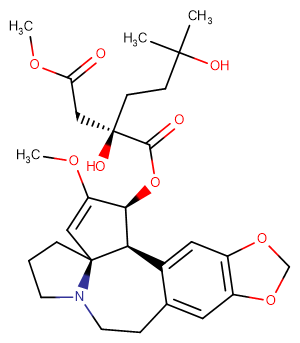
Harringtonine
CAS No. 26833-85-2
Harringtonine( —— )
Catalog No. M21497 CAS No. 26833-85-2
Harringtonine a natural Cephalotaxus alkaloid inhibits protein synthesis.
Purity : >98% (HPLC)
 COA
COA
 Datasheet
Datasheet
 HNMR
HNMR
 HPLC
HPLC
 MSDS
MSDS
 Handing Instructions
Handing Instructions
| Size | Price / USD | Stock | Quantity |
| 5MG | 71 | Get Quote |


|
| 10MG | 107 | Get Quote |


|
| 25MG | 178 | Get Quote |


|
| 50MG | 266 | Get Quote |


|
| 100MG | Get Quote | Get Quote |


|
| 200MG | Get Quote | Get Quote |


|
| 500MG | Get Quote | Get Quote |


|
| 1G | Get Quote | Get Quote |


|
Biological Information
-
Product NameHarringtonine
-
NoteResearch use only, not for human use.
-
Brief DescriptionHarringtonine a natural Cephalotaxus alkaloid inhibits protein synthesis.
-
DescriptionHarringtonine a natural Cephalotaxus alkaloid inhibits protein synthesis.(In Vitro):Harringtonine inhibits the elongation phase of translation by preventing substrate binding to the acceptor site on the 60-S ribosome subunit and therefore block aminoacyl-tRNA binding and peptide bond formation. Harringtonine displays potent inhibition of Chikungunya virus infection with an EC50 of 0.24 μM. Harringtonine could inhibit other alphaviruses. Harringtonine inhibits the growth of human myeloid leukemia cells in vitro at low concentrations. The mechanism of the antitumor action of harringtonine is considered to be an effect on protein synthesis and is characterized by breakdown of polysomes to monosomes.
-
In VitroHarringtonine inhibits the elongation phase of translation by preventing substrate binding to the acceptor site on the 60-S ribosome subunit and therefore block aminoacyl-tRNA binding and peptide bond formation. Harringtonine displays potent inhibition of Chikungunya virus infection with an EC50 of 0.24 μM. Harringtonine could inhibit other alphaviruses. Harringtonine inhibits the growth of human myeloid leukemia cells in vitro at low concentrations. The mechanism of the antitumor action of harringtonine is considered to be an effect on protein synthesis and is characterized by breakdown of polysomes to monosomes.
-
In Vivo——
-
Synonyms——
-
PathwayOthers
-
TargetOther Targets
-
RecptorOthers
-
Research Areacancer
-
IndicationLeukemia
Chemical Information
-
CAS Number26833-85-2
-
Formula Weight531.59
-
Molecular FormulaC28H37NO9
-
Purity>98% (HPLC)
-
SolubilityDMSO:1 mg/mL (188.11 mM)
-
SMILESCC(C)(CC[C@@](CC(=O)OC)(C(=O)O[C@H]1[C@H]2C3=CC4=C(C=C3CCN5[C@@]2(CCC5)C=C1OC)OCO4)O)O
-
Chemical Name1-((1S3aR14bS)-2-methoxy-1568914b-hexahydro-4H-[13]dioxolo[4'5':45]benzo[12-d]cyclopenta[b]pyrrolo[12-a]azepin-1-yl) 4-methyl (R)-2-hydroxy-2-(3-hydroxy-3-methylbutyl)succinate
Shipping & Storage Information
-
Storage(-20℃)
-
ShippingWith Ice Pack
-
Stability≥ 2 years
Reference
1.Fresno M et al. Inhibition of translation in eukaryotic systems by harringtonine. Eur J Biochem. 1977 Jan;72(2):323-30.
molnova catalog



related products
-
Coelonin
Coelonin shows moderate cytotoxic activity against HepG2 cells.
-
5-Hydroxypseudobapti...
The herbs of Lupinus luteus.
-
KIRA6
KIRA6 is an effective inhibitor of IRE1α RNase kinase (IC50: 0.6 μM). It can trigger an apoptotic response.KIRA6 (10-1000 nM, 72 hours) strongly compromises the viability of the KIT-dependent cell line HMC-1.1 at the low nM concentration, in a manner that coincided with KIT blockade.



 Cart
Cart
 sales@molnova.com
sales@molnova.com


